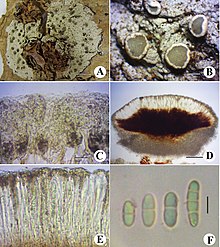Scutula is a genus of lichenicolous fungi in the family Ramalinaceae.

The Peltigeraceae are a family of lichens in the order Peltigerales. The Peltigeraceae, which contains 15 genera and about 600 species, has recently (2018) been emended to include the families Lobariaceae and Nephromataceae. Many Peltigeraceae species have large and conspicuous, leathery thalli. They largely occur in cool-temperate to tropical montane climates. Tripartite thalli involving fungus, green algae and cyanobacteria are common in this family.

The Catillariaceae are a family of crustose lichens in the order Lecanorales. Species of this family have a widespread distribution, especially in temperate areas. The family was originally circumscribed by Austrian lichenologist Josef Hafellner in 1984.
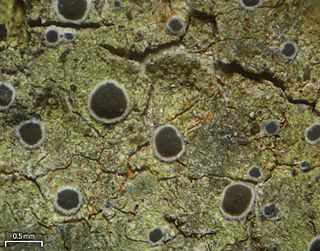
The Pilocarpaceae are a family of crustose lichens in the order Lecanorales. The species of this family have a cosmopolitan distribution and have been found in a variety of climatic regions. Pilocarpaceae was circumscribed by Alexander Zahlbruckner in Adolf Engler's influential 1905 work Die Natürlichen Pflanzenfamilien.
Aciculopsora is a genus of lichens in the family Ramalinaceae. It was circumscribed by lichenologists André Aptroot and Marie Trest in 2006.
Lueckingia is a genus in the family Ramalinaceae. It is a monotypic genus, containing the single corticolous lichen species Lueckingia polyspora. The genus and species were described as new to science in 2006. The species, known only from Costa Rica, was originally found growing on bark in the shaded understory of a lowland rainforest. The genus name honours German lichenologist Robert Lücking (b.1964), who organized the field trip that resulted in the discovery of the new species.
Badimia is a genus of foliicolous (leaf-inhabiting) lichens in the family Ramalinaceae.
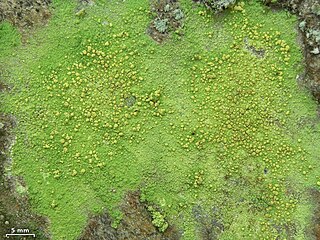
Psilolechia is a genus of four species of crustose lichens. It is the only member of Psilolechiaceae, a family that was created in 2014 to contain this genus.
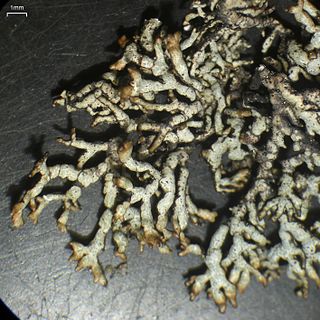
Brodoa is a genus of three species of foliose lichens in the family Parmeliaceae. The genus, circumscribed in 1986 by Trevor Goward, is named in honour of lichenologist Irwin Brodo.

Melanelia is a genus of lichenized fungi in the family Parmeliaceae. The genus was circumscribed by Ted Esslinger in 1978.

Flavoparmelia is a genus of foliose lichens in the family Parmeliaceae. Because of their appearance, they are commonly known as greenshield lichens. The widely distributed genus contains 32 species. It was circumscribed by American lichenologist Mason Hale in 1986 to contain 17 former Pseudoparmelia species with broad lobes, usnic acid in the cortex, and isolichenan in the cell walls.
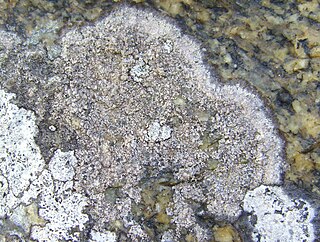
Llimonaea is a genus of fungi within the Arthoniales order. The genus has been placed into Opegraphaceae.
Sipmania is a genus of lichenized fungi within the order Arthoniales. The genus has been placed into the family Roccellaceae. This is a monotypic genus, containing the single species Sipmania peltata.

Protoparmelia is a genus of lichenized fungi in the family Parmeliaceae. The genus has a widespread distribution, and contains 11 species. Protoparmelia was circumscribed by French lichenologist Maurice Choisy in 1929.

Malmideaceae is a family of crustose and corticolous lichens in the order Lecanorales. It contains eight genera and about 70 species.
Sprucidea is a genus of four crustose lichens in the family Malmideaceae. Similar to the related genus Malmidea, Sprucidea is characterized by frequently red thalli that contain the secondary compound norsolorinic acid, but differs in the rod-shaped instead of ellipsoid ascospores and in the stalked sporodochia as conidiomata. Sprucidea species are found in rainforest areas in South America and Southeast Asia.

Notoparmelia is a genus of foliose lichens in the family Parmeliaceae. It includes 18 species that grow on bark and rocks, and are mostly distributed in the Southern Hemisphere. The genus was created in 2014 as a segregate of Parmelia.
Austromelanelixia is a genus of five species of foliose lichens in the family Parmeliaceae. All species are found in the Southern Hemisphere.
Bruceomycetaceae is a small family of fungi in the order Lecanorales. It contains two genera, each of which contains a single species.

Thelenellaceae is a family of lichen-forming fungi. It is the sole family in the monotypic order Thelenellales, and contains three genera and about 50 species.
